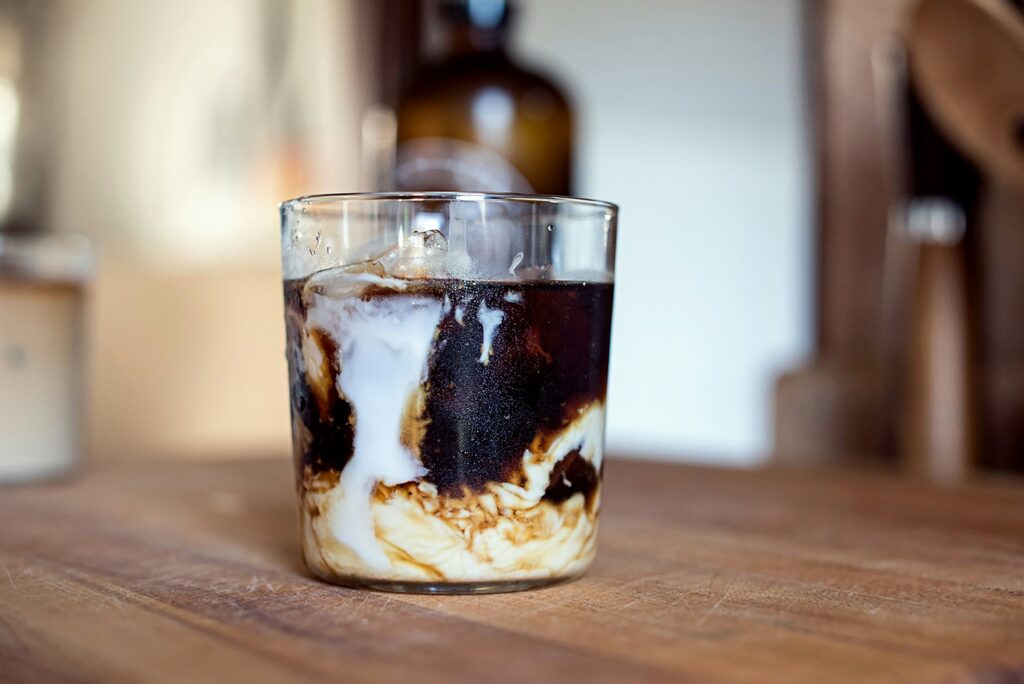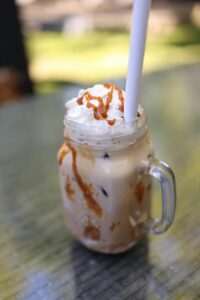Cold brew isn’t just coffee, but it’s a whole vibe. Smooth, bold, and refreshingly easy to sip, it’s no wonder more people are swapping their hot mugs for a chilled glass.
But here’s the kicker: the beans you choose decide whether your cold brew tastes like liquid velvet or a bitter swamp. The right beans bring out that signature low acidity and deep flavor you crave.
In this guide, you’ll find the best picks for cold brew lovers, from classic chocolatey blends to adventurous fruity notes.
What Makes a Coffee Bean Great for Cold Brew?
What makes a coffee bean perfect for cold brew comes down to balance, depth, and how the flavors unfold when brewed slowly in cold water.
Cold brew naturally reduces acidity, so beans with a smooth profile—think chocolate, caramel, or nutty undertones—shine brightest, while super bright and citrusy beans can sometimes taste flat or even sour.
That’s why medium to dark roasts are often the sweet spot: medium roasts keep a touch of brightness with balanced sweetness, while dark roasts lean into bold, rich, and almost chocolate-like flavors; light roasts, on the other hand, can taste a little too sharp when brewed cold, though adventurous drinkers may enjoy their fruity punch.
The real magic comes from flavor notes that mellow and deepen—caramel turns syrupy, nuttiness becomes creamy, and chocolate takes on that smooth, dessert-like finish.
But no matter the roast, freshness is non-negotiable; stale beans make stale-tasting coffee, plain and simple.
Grind size matters too: coarse grounds are best because they slow extraction, reduce bitterness, and make filtering less messy, giving you that clean, silky concentrate that makes cold brew such a treat.
Arabica vs. Robusta for Cold Brew
When it comes to cold brew, the Arabica vs. Robusta debate is like choosing between a smooth jazz playlist and a heavy metal concert—both have their moments, but the vibe is completely different.
Arabica beans are prized for their sweeter, more nuanced flavors, often carrying hints of fruit, caramel, or chocolate, and they naturally have less bitterness, which makes them a favorite for those who want a silky, easy-drinking cold brew.
Robusta, on the other hand, packs nearly double the caffeine and brings a bold, sometimes earthy bitterness that can give your brew a serious kick; it’s the kind of bean that wakes you up before your alarm clock does.
For most cold brew lovers, Arabica steals the show because its low acidity and layered flavors bloom beautifully in a long steep, but don’t count Robusta out because when blended in small amounts with Arabica, it can add body, extra caffeine, and just enough edge to keep things interesting.
Roast Levels and Their Impact
Roast level changes everything about your cold brew, almost like swapping the soundtrack to a movie—you’ll still get coffee, but the mood shifts completely.
Light roasts bring fruity, floral, and tea-like notes that sparkle in hot brewing, yet in cold brew, they can sometimes taste too sharp or acidic, making them more of an acquired taste for adventurous drinkers.
Medium roasts sit right in the middle, offering balance, smoothness, and versatility; they carry enough sweetness and depth to please most palates, which makes them a safe but satisfying choice if you’re just starting out.
Dark roasts, though, are the go-to for many cold brew fans because they lean heavily into bold, chocolatey, and rich flavors that mellow into something smooth and almost dessert-like when brewed cold.
Each roast has its place: light roast if you want a unique, fruity surprise, medium for an all-around crowd-pleaser, and dark if you crave that deep, indulgent “coffee shop cold brew” experience.
Flavor Profiles Cold Brew Lovers Crave
Cold brew has a way of spotlighting certain flavors, and the profiles people crave often feel like dessert in a glass or sometimes a daring flavor adventure.
Chocolate and nutty beans are the classics, giving you that smooth, comforting taste that feels like a chocolate bar melted into your cup, with hazelnut or almond notes rounding it out.
Caramel and sweet undertones take things up a notch, offering a natural sweetness that makes your brew taste like it already has a splash of syrup, perfect for those who like indulgence without added sugar.
Fruity and floral beans, often from African origins like Ethiopia or Kenya, bring bright, almost wine-like flavors that turn your cold brew into a bold experiment; not everyone loves them, but if you enjoy surprises, they can be thrilling.
Then there are spicy and earthy notes, found in beans from places like Sumatra, which create a darker, bolder cup that feels robust and grounding, almost like coffee’s equivalent of a hearty stew.
Best Coffee Beans for Cold Brew (Top Picks)
Single-Origin Recommendations
Single-origin beans give you a pure taste of place, almost like taking a flavor trip without leaving your kitchen.
Ethiopian beans often shine with fruity, floral notes that feel lively and refreshing, though they’re best for adventurous drinkers who don’t mind a little tang.
Colombian beans are the reliable friend you can always count on—balanced, smooth, and often with caramel undertones that make cold brew naturally sweet.
Brazilian beans lean heavily toward nutty and chocolatey flavors, creating a silky, dessert-like brew that’s a hit for anyone who loves indulgent coffee without needing extras.
Then you’ve got Sumatran beans, which are earthy, bold, and sometimes a little spicy; they make a cold brew that feels heavy, grounding, and almost savory in comparison to brighter origins.
Blends Designed for Cold Brew
Some roasters create blends specifically crafted for cold brew, and these can be game-changers if you’re after consistency and a well-rounded flavor.
These blends usually combine the sweetness of Arabica with the punch of Robusta or mix different regions to create layers of flavor that pop when brewed cold.
Another thing to think about is pre-ground vs. whole bean: pre-ground is convenient but loses freshness faster, while grinding whole beans at home right before brewing guarantees a brighter, more flavorful cup.
Budget-Friendly Picks
You don’t need to break the bank to enjoy good cold brew. Plenty of grocery store beans still shine when steeped overnight, especially medium or dark roasts with chocolate or nutty flavor notes.
Brands that may taste “meh” as hot coffee can actually surprise you as cold brew because the slow steeping pulls out sweetness while muting bitterness.
The trick is to buy smaller bags, keep them fresh, and stick to beans with tasting notes that match the flavors you enjoy most.
How to Choose Beans for Your Taste
Match Roast to Your Flavor Preference
The first step is knowing what you like. If you enjoy bold, chocolatey flavors, a dark roast is your best friend. If you prefer balance with a touch of sweetness, medium roasts will keep you happy.
And if you’re curious about fruitier or floral notes, light roasts can be worth the experiment, even if they’re trickier in cold brew.
Matching the roast to your taste saves you from wasting time (and beans) on flavors that just don’t click.
Experiment with Small Bags Before Committing
Buying small bags lets you try different beans without filling your pantry with half-finished bags you’ll never touch again. Many roasters even sell sampler packs designed for cold brew.
Testing a few side-by-side is the fastest way to learn what your taste buds actually enjoy.
Keep Grind Freshness in Mind
No matter how good the beans are, if they’re ground too early, the flavor fades. Oxygen and time are the enemies here.
Whole beans ground right before brewing give you brighter, fuller cold brew every time.
If you only have access to pre-ground coffee, look for smaller packages and use them quickly before the flavor dulls.
Try Blending Beans for Unique Cold Brew Flavor
Sometimes the magic happens when you mix things up.
Blending beans lets you combine strengths: maybe a chocolatey Brazilian with a fruity Ethiopian, or a smooth Colombian cut with a punch of Robusta for extra caffeine.
With blending, you’re not stuck choosing between sweet or bold; you can have both in one brew.
Brewing Tips to Maximize Bean Potential
Grind Size: Coarse for Clarity, Medium-Coarse for More Body
Grind size can make or break your cold brew. A coarse grind gives you a clean, crisp cup that’s easy to filter and less likely to turn bitter.
If you want more body and a slightly heavier flavor, leaning toward medium-coarse works well, but avoid going too fine; otherwise, you’ll end up with over-extraction and sludge at the bottom of your jar.
Brew Ratio (1:4 to 1:8 Concentrate vs. Ready-to-Drink)
The ratio you use decides how strong your cold brew turns out. A 1:4 ratio (one part coffee to four parts water) gives you a concentrate that’s bold and meant to be diluted with water or milk.
A 1:8 ratio brews something closer to ready-to-drink strength because it’s milder, smoother, and easier for beginners. Neither is right nor wrong; it’s more about whether you want flexibility or convenience.
Steeping Time: 12–24 Hours
Patience is key with cold brew. Steeping for at least 12 hours lets the flavors develop, but pushing it closer to 18–24 hours draws out deeper, richer notes.
Go too short and you’ll end up with something weak. Go too long and the flavors can turn overly bitter or woody.
The sweet spot depends on your beans and taste preference, so testing different times is part of the fun.
Storing Your Cold Brew Concentrate for Freshness
Once your cold brew is ready, don’t just let it sit uncovered in the fridge. Store it in an airtight container or bottle to keep oxygen out and flavors intact.
Concentrate typically lasts about a week, though the best flavor is usually in the first 3–4 days.
If you’ve ever pulled leftovers from the fridge only to taste something flat and stale, you know why storage matters.
Treat it like you would leftovers from a good meal—seal it up and enjoy it before it loses its charm.
Final Words
At the end of the day, your beans are the steering wheel of your cold brew, and they decide where the flavor journey goes. Pick wisely, and every sip feels smooth and satisfying.
Stick with the same old bag, and you might be missing out on a whole world of taste. The fun is in experimenting until you find the one that makes you say, “Yep, that’s my brew.”
So here’s your challenge: grab one new type of bean this week and see how it changes your cup. Who knows? Your new favorite might be waiting in the next jar you steep.
FAQs
Can I use espresso beans for cold brew?
Yes, but with a caveat. Espresso beans are often dark roasted, which can make for a bold, chocolatey cold brew.
Just be sure to grind them coarse because using an espresso grind will turn your batch bitter and muddy.
Is pre-ground coffee okay for cold brew?
It works in a pinch, but it’s not ideal. Pre-ground coffee loses freshness quickly, and cold brew really benefits from bold, fresh flavors. If you do go pre-ground, use it fast and store it airtight.
Do flavored beans work well in cold brew?
They can, but it depends on your taste. The slow steeping process can mellow artificial flavors, sometimes leaving a strange aftertaste.
If you like flavored coffee, try adding syrups or spices after brewing instead, because it’s more consistent and customizable.
Can I mix different beans for cold brew?
Absolutely. Blending beans can create unique flavors and balance. A nutty Brazilian paired with a fruity Ethiopian, for example, gives you both comfort and brightness.
It’s like building your own signature cold brew blend at home.



